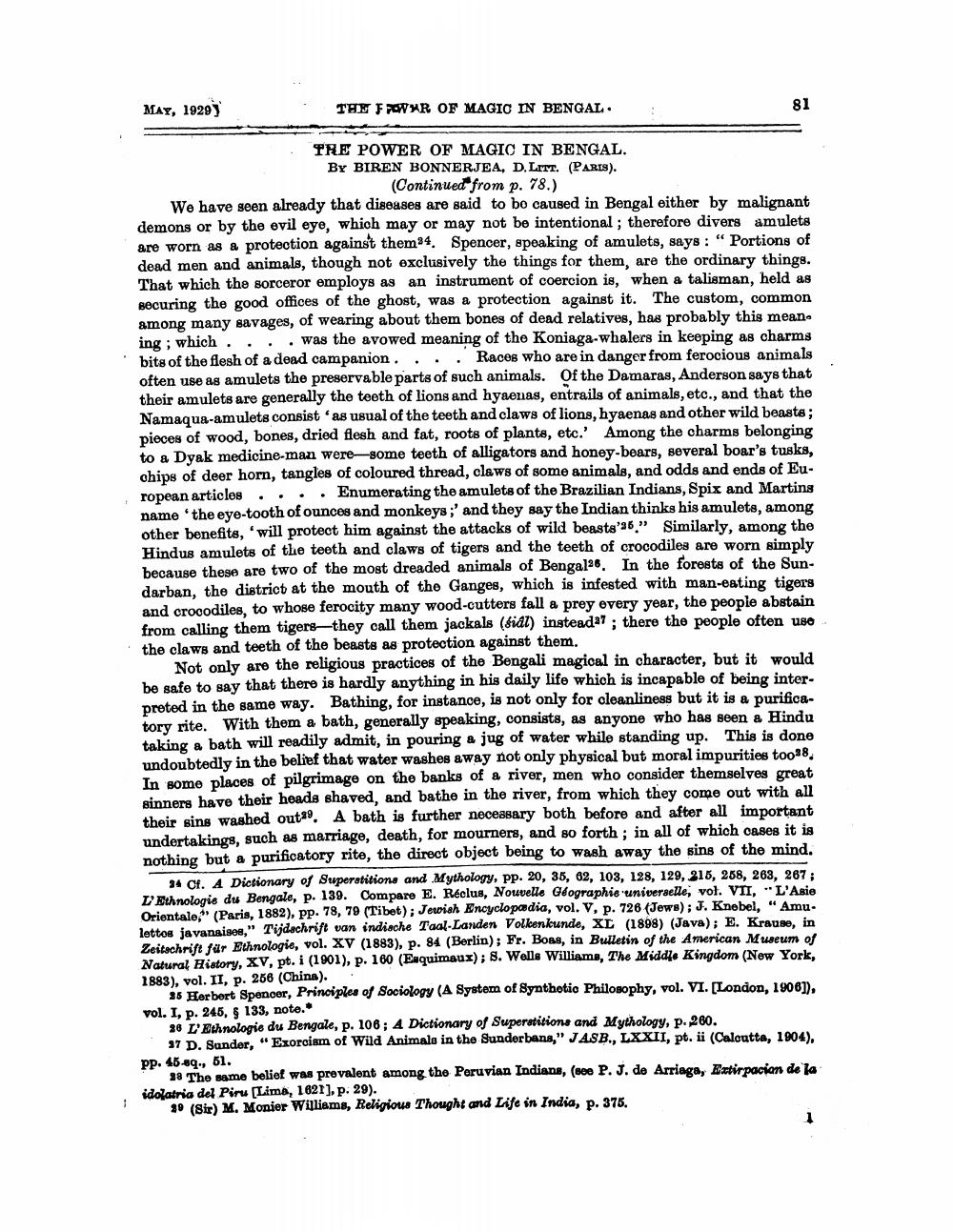________________
MAY, 1920
THE WAR OF MAGIC IN BENGAL.
81
THE POWER OF MAGIC IN BENGAL. BY BIREN BONNERJEA, D. LITT. (PARIS). (Continued from p. 78.)
We have seen already that diseases are said to bo caused in Bengal either by malignant demons or by the evil eye, which may or may not be intentional; therefore divers amulets Portions of are worn as a protection against them34. Spencer, speaking of amulets, says: dead men and animals, though not exclusively the things for them, are the ordinary things. That which the sorceror employs as an instrument of coercion is, when a talisman, held as securing the good offices of the ghost, was a protection against it. The custom, common among many savages, of wearing about them bones of dead relatives, has probably this mean. ing; which. . . . was the avowed meaning of the Koniaga-whalers in keeping as charms bits of the flesh of a dead campanion. . . . Races who are in danger from ferocious animals often use as amulets the preservable parts of such animals. Of the Damaras, Anderson says that their amulets are generally the teeth of lions and hyaenas, entrails of animals, etc., and that the Namaqua-amulets consist as usual of the teeth and claws of lions, hyaenas and other wild beasts; pieces of wood, bones, dried flesh and fat, roots of plants, etc.' Among the charms belonging to a Dyak medicine-man were some teeth of alligators and honey-bears, several boar's tusks, chips of deer horn, tangles of coloured thread, claws of some animals, and odds and ends of European articles.... Enumerating the amulets of the Brazilian Indians, Spix and Martins name 'the eye-tooth of ounces and monkeys;' and they say the Indian thinks his amulets, among other benefits, 'will protect him against the attacks of wild beasts'36" Similarly, among the Hindus amulets of the teeth and claws of tigers and the teeth of crocodiles are worn simply because these are two of the most dreaded animals of Bengal36. In the forests of the Sundarban, the district at the mouth of the Ganges, which is infested with man-eating tigers and crocodiles, to whose ferocity many wood-cutters fall a prey every year, the people abstain from calling them tigers-they call them jackals (sidl) instead27; there the people often use the claws and teeth of the beasts as protection against them.
Not only are the religious practices of the Bengali magical in character, but it would be safe to say that there is hardly anything in his daily life which is incapable of being interpreted in the same way. Bathing, for instance, is not only for cleanliness but it is a purificatory rite. With them a bath, generally speaking, consists, as anyone who has seen a Hindu taking a bath will readily admit, in pouring a jug of water while standing up. This is done undoubtedly in the belief that water washes away not only physical but moral impurities too38. In some places of pilgrimage on the banks of a river, men who consider themselves great sinners have their heads shaved, and bathe in the river, from which they come out with all their sins washed out29. A bath is further necessary both before and after all important undertakings, such as marriage, death, for mourners, and so forth; in all of which cases it is nothing but a purificatory rite, the direct object being to wash away the sins of the mind.
34 Cf. A Dictionary of Superstitions and Mythology, pp. 20, 35, 62, 103, 128, 129, 215, 258, 263, 267; L'Ethnologie du Bengale, p. 139. Compare E. Réclus, Nouvelle Géographie universelle, vol. VII, L'Asie Orientale," (Paris, 1882), pp. 78, 79 (Tibet); Jewish Encyclopædia, vol. V, p. 726 (Jews); J. Knebel, "Amulettos javanaises," Tijdschrift van indische Taal-Landen Volkenkunde, XL (1898) (Java); E. Krause, in Zeitschrift für Ethnologie, vol. XV (1883), p. 84 (Berlin); Fr. Boss, in Bulletin of the American Museum of Natural History, XV, pt. i (1901), p. 160 (Esquimaux); S. Wells Williams, The Middle Kingdom (New York, 1883), vol. II, p. 256 (China).
25 Herbert Spencer, Principles of Sociology (A System of Synthetic Philosophy, vol. VI. [London, 1906]), vol. I, p. 245, § 133, note.*
28 L'Ethnologie du Bengale, p. 106; 4 Dictionary of Superstitions and Mythology, p. 260.
37 D. Sunder, "Exorcism of Wild Animals in the Sunderbans," JASB., LXXII, pt. ii (Calcutta, 1904), pp. 45.8q., 51.
28 The same belief was prevalent among the Peruvian Indians, (see P. J. de Arriaga, Extirpacion de la idolatria del Piru [Lima, 1621], p. 29).
39 (Sir) M. Monier Williams, Religious Thought and Life in India, p. 375.




